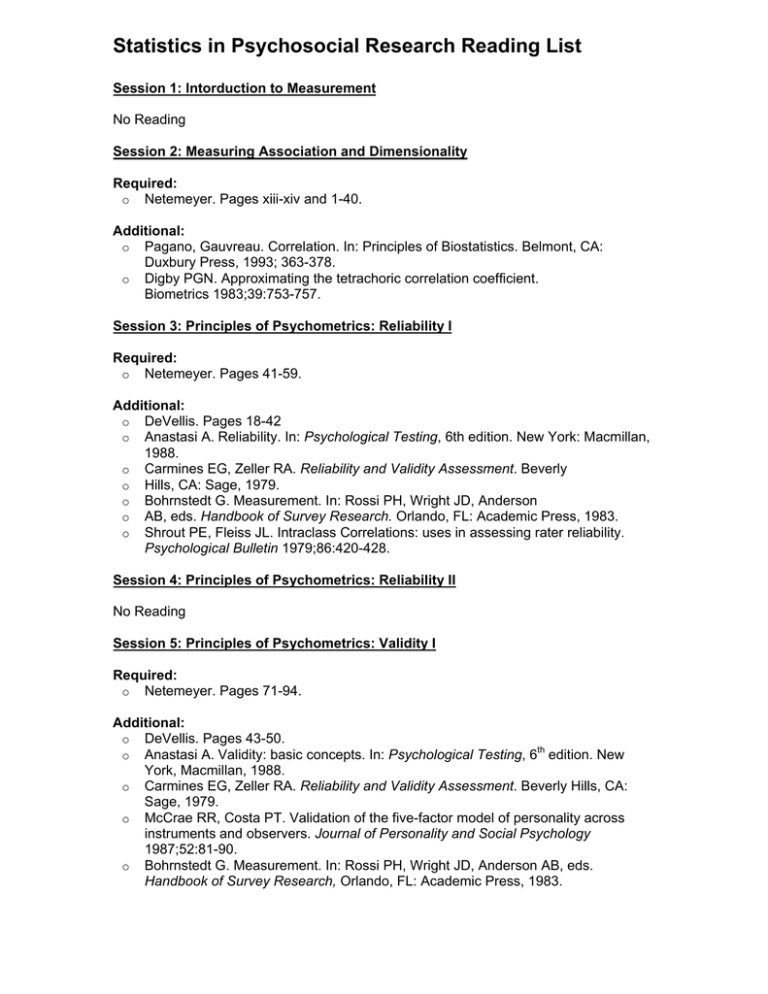Statistics in Psychosocial Research Reading List
advertisement

Statistics in Psychosocial Research Reading List Session 1: Intorduction to Measurement No Reading Session 2: Measuring Association and Dimensionality Required: o Netemeyer. Pages xiii-xiv and 1-40. Additional: o Pagano, Gauvreau. Correlation. In: Principles of Biostatistics. Belmont, CA: Duxbury Press, 1993; 363-378. o Digby PGN. Approximating the tetrachoric correlation coefficient. Biometrics 1983;39:753-757. Session 3: Principles of Psychometrics: Reliability I Required: o Netemeyer. Pages 41-59. Additional: o DeVellis. Pages 18-42 o Anastasi A. Reliability. In: Psychological Testing, 6th edition. New York: Macmillan, 1988. o Carmines EG, Zeller RA. Reliability and Validity Assessment. Beverly o Hills, CA: Sage, 1979. o Bohrnstedt G. Measurement. In: Rossi PH, Wright JD, Anderson o AB, eds. Handbook of Survey Research. Orlando, FL: Academic Press, 1983. o Shrout PE, Fleiss JL. Intraclass Correlations: uses in assessing rater reliability. Psychological Bulletin 1979;86:420-428. Session 4: Principles of Psychometrics: Reliability II No Reading Session 5: Principles of Psychometrics: Validity I Required: o Netemeyer. Pages 71-94. Additional: o DeVellis. Pages 43-50. o Anastasi A. Validity: basic concepts. In: Psychological Testing, 6th edition. New York, Macmillan, 1988. o Carmines EG, Zeller RA. Reliability and Validity Assessment. Beverly Hills, CA: Sage, 1979. o McCrae RR, Costa PT. Validation of the five-factor model of personality across instruments and observers. Journal of Personality and Social Psychology 1987;52:81-90. o Bohrnstedt G. Measurement. In: Rossi PH, Wright JD, Anderson AB, eds. Handbook of Survey Research, Orlando, FL: Academic Press, 1983. Session 6: Principles of Psychometrics: Validity II No Reading Session 7: Scale Development Required: o Netemeyer. Pages 94-107. o Streiner DL, Norman GR. From items to scales. In: Health Measurement Scales: A Practical Guide to Their Development and Use. 2nd edition. New York: Oxford University Press, 1995; 96-102. o Murphy JM, et al. Performance of screening and diagnostic tests. Archives of General Psychiatry 1987;44:550-555. Session 8: Factor Analysis I Required: o Netemeyer. Pages 115-170. Additional: o DeVellis. pages 91-109. o Kim J-O, Mueller CW. Factor Analysis: Statistical Methods and Practical Issues, Beverly Hills, CA: Sage Publications, 1988. o Everitt B, Dunn G. Factor analysis. In: Applied Multivariate Data Analysis. London: Arnold Press, 2001. Session 9: Factor Analysis II Additional: o Everitt B, Dunn G. Principal components analysis. In: Applied Multivariate Data Analysis. London: Arnold, 2001. o Fisher LD, Van Belle G. Principal component analysis and factor analysis. In: Biostatistics: A Methodology for the Health Sciences, New York: John Wiley & Sons, 1993; 692-762. o Johnson RA, Wichern DW. Principal components analysis (Chapter 8) and Factor Analysis and Inference for Structured Covariance Matrices (Chapter 9) In: Applied Multivariate Statistical Analysis, 2nd edition. Englewood Cliffs, NJ: Prentice Hall, 1988. o Long JS. Confirmatory Factor Analysis: A Preface to LISREL. Beverly Hills, CA: Sage, 1983. o Muthen B. A general structural equation model with dichotomous, ordered categorical, and continuous latent variable indicators. Psychometrika 1984;49:115132. o Eaton WW, Bohrnstedt GW, eds. Latent Variable Models for Dichotomous Outcomes: Analysis of Data from the NIMH Epidemiologic Catchment Area Program. Newbury Park: Sage Publications, 1989 Session 10: Factor Analysis III Required: o Shapiro, Lasarev, McCauley. Factor Analysis of Gulf War Illness: What does it add to our understanding of possible health effects of deployment. Am J Epidemiol 2002;156:578-585. o o o Lakka, Laaksonen, Lakka, Niskanen, Kumpausalo, Tuomilehto, Salonen. The metabolic syndrome and total and cardiovascular disease mortality in middle-aged men. JAMA 2002;288:2709-2716. Hoodin, Kalbfleisch. Factor analysis and validity of the Transplant Evaluation Rating Scale in a large bone marrow transplant sample. Journal of Psychosomatic Research 2003;54:465-473. Costa PT, McCrae RR Four ways five factors are basic. In: Personality and Individual Differences 1992;13:653-665 Session 11: Latent Class Analysis I Required: o McCutcheon A. Chapters 1 and 2. Latent Class Analysis, Newbury Park: Sage, 1987. Recommended: o Uebersax J. LCA Frequently Asked Questions. Session 12: Latent Class Analysis II Required: o McCutcheon A. Chapter 3. In: Latent Class Analysis, Newbury Park, Sage, 1987. Session 13: Latent Class Required: o Nestadt, Addington, Samuels, Liang, Bienvenu, Riddle, Grados, Hoehn-Saric, Cullen. The Identification of OCD-Related Subgroups Based on Comorbidity. Biological Psychiatry 2003;53:914-920. o Eaton WW, Dryman A, Sorenson A, McCutcheon A. DSM-III major depressive disorder in the community. A latent class analysis of data from the NIMH epidemiologic catchment area programme. British Journal of Psychiatry. 1989;155:48-54. o Sullivan PF, Kessler RC, Kendler KS. Latent class analysis of lifetime depressive symptoms in the national comorbidity survey. Am J Psychiatry 1998;155;13971406. o Reboussin BA, Song E-Y, Shrestha A, Lohman KK, Wolfson M. A latent class analysis of underage problem drinking : Evidence from a community sample of 1620 year olds. Drug and Alcohol Dependence 2006;83:199-209. Session 14: Sample Size in Reliability and Factor Analysis Required: o MacCallum RC, Widaman KF, Shaobo Z, Hong S. Sample size in factor analysis. Psychological Methods 1999;4:84-99.



